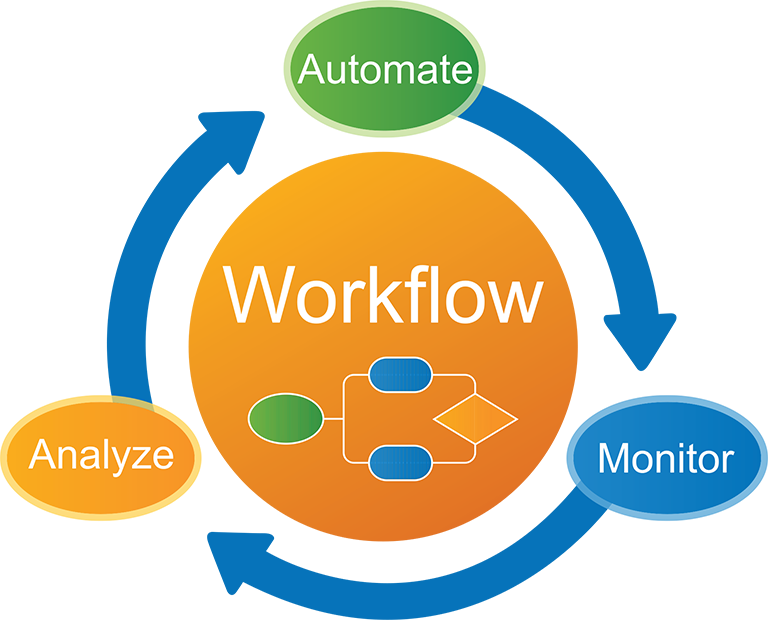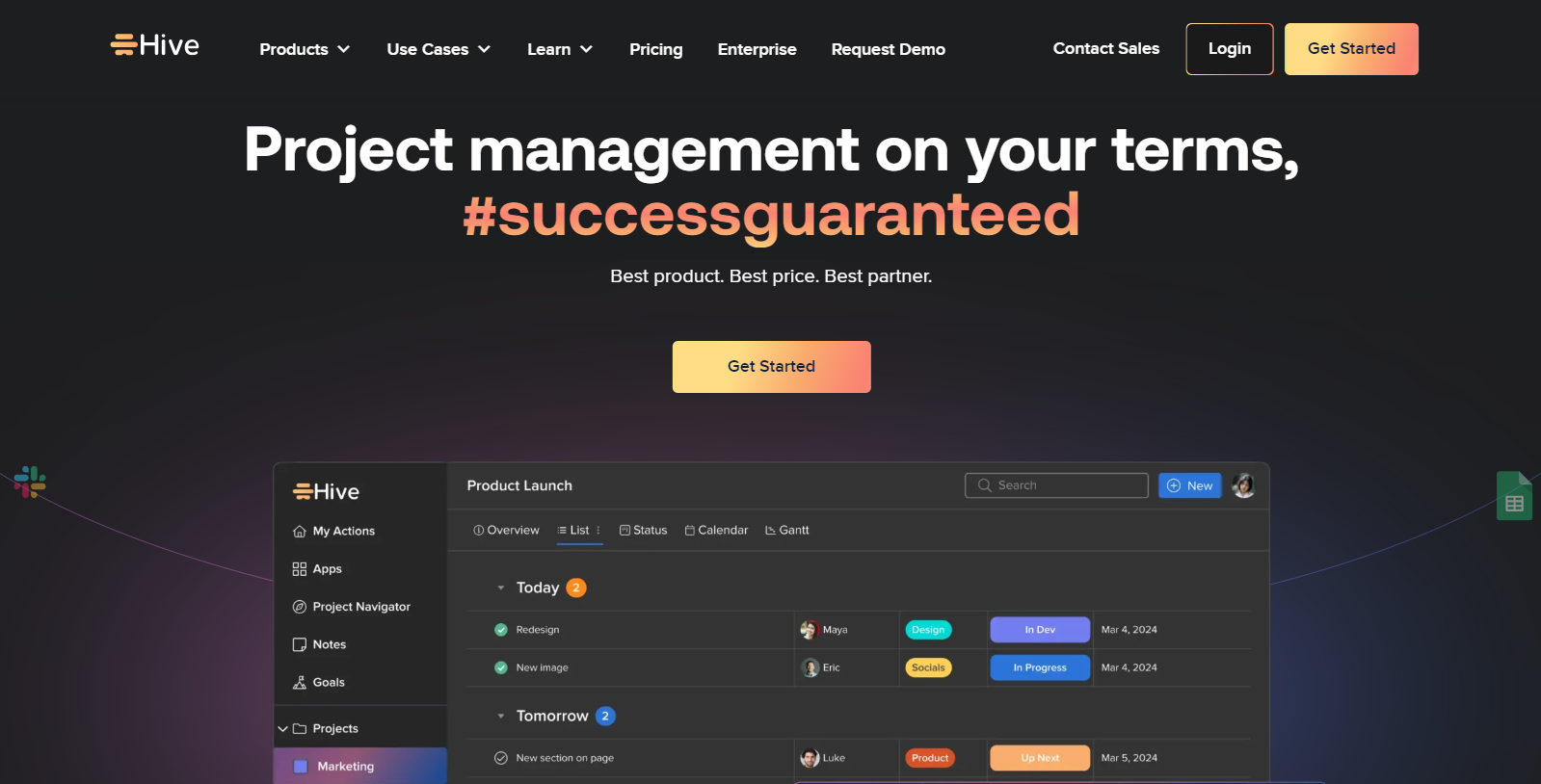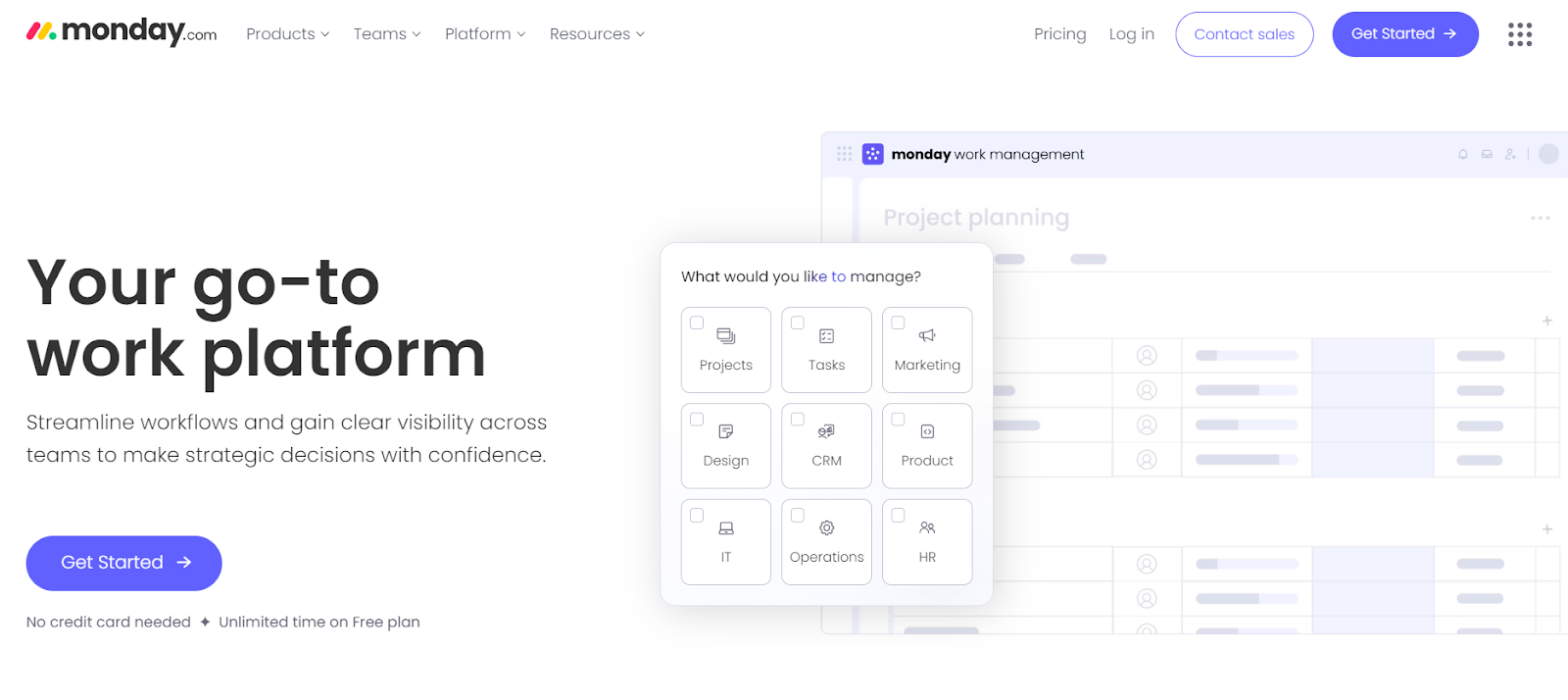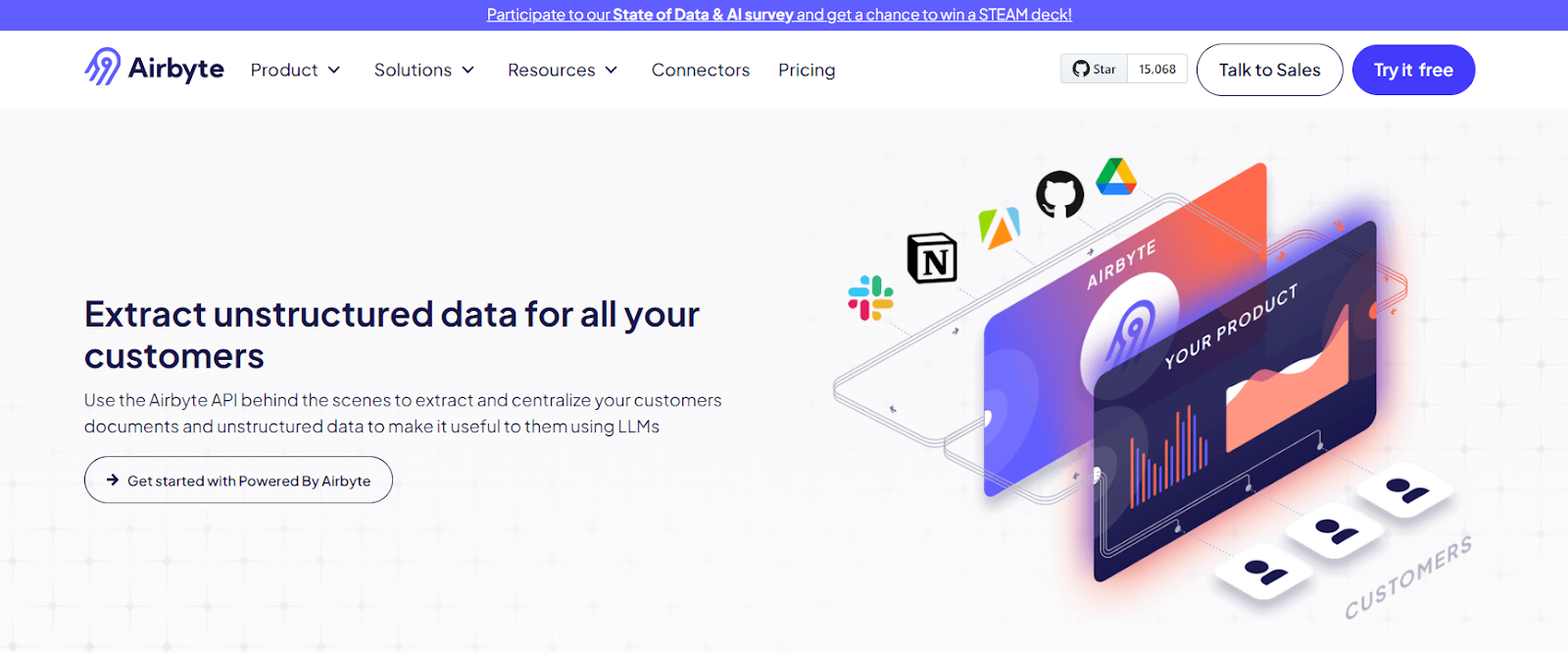Enterprise Workflow Automation: Benefits, Examples, & Tools
Summarize this article with:
✨ AI Generated Summary
Enterprise workflow automation streamlines repetitive and complex tasks across departments like HR, finance, customer service, and sales, improving efficiency, reducing costs, and minimizing human errors. Key benefits include faster response times, regulatory compliance, scalability, and enhanced data-driven decision-making. Popular tools such as Cflow, Hive, Smartsheet, and Monday.com facilitate automation, while data integration platforms like Airbyte ensure quality data management to support these workflows.
Enterprise workflow is a sequence of interconnected tasks that an enterprise follows to achieve a specific objective. Employee onboarding, salary processing, and customer support are some operations involved in enterprise workflows. However, these workflows are mostly repetitive and time-consuming when implemented manually. As a result, companies nowadays are opting for automation to complete such tasks. This saves time and money and enhances the productivity of the overall enterprise.
This article comprehensively explains enterprise workflow automation. It helps you understand the importance of automating workflows in your company, the tools that can assist you achieve it, and the practical applications of these automated workflows.
What Is Enterprise Workflow Automation?

Enterprise workflow automation is the process of automating repetitive or complex tasks in an enterprise using specialized software and technologies. By deploying this automation software across various departments, you can streamline operations that do not require human intervention for completion.
This decreases your employees' workload, allowing them to direct their efforts toward more significant business operations. As a result, enterprise workflow automation improves your organization's operational efficiency and overall productivity.
Importance of Workflow Automation For Enterprises
Workflow automation is essential for enterprises because of the following reasons:
Streamlines Repetitive Tasks
Workflow automation eliminates the need to perform repetitive tasks such as data entry, scheduling regular team meetings, email marketing, and inventory management. By automating such tasks, you can achieve better time management and enhanced productivity.
Lowers Operational Costs
Businesses report a 30% reduction in costs after implementing workflow automation. This reduction is primarily due to the decreased need for hiring additional human resources to perform iterative tasks. Moreover, workflow automation software optimizes the use of resources required to perform various processes, which further leads to cost-cutting.
Reduces Human Errors
Workflow automation significantly reduces human errors, ensuring accuracy in task completion. It also promotes consistency and avoids deviations by adhering to the predefined set of rules and procedures. This reduction in human errors not only lowers the cost of rework but also saves the time that would otherwise be spent rectifying errors in manual processes.
Enables Data-driven Decision-making
Most organization departments, such as finance, marketing, sales, or human resources, rely heavily on data. Workflow automation streamlines the processes of data collection, integration, transformation, and standardization within these departments.
The automation tools enable you to perform all these processes with minimal errors and in near real-time. This enables you to draw meaningful data-driven insights that you can use to make informed decisions for the growth of your enterprise.
Ensures Regulatory Compliance
Workflow automation helps ensure that your enterprise operations adhere to regulatory frameworks like GDPR or HIPAA. This facilitates data protection and minimizes the possibility of data breaches.
Easily Adapts to Business Growth
As your business grows, automated systems can handle increased volumes of tasks without requiring additional human resources. This scalability ensures your operations remain efficient even if demand increases.
Faster Response Times to Customer Queries
Workflow automation strengthens your customer service by routing each query to its specific department, leading to faster resolution. You can also use chatbots or automated response systems to answer frequently asked questions by customers. All these contribute to increased customer satisfaction and loyalty.
Enterprise Workflow Automation Use Cases
Here are some use cases of workflow automation across various enterprise departments:
Human Resources
Using enterprise workflow automation, you can streamline human resource processes such as recruitment, onboarding, salary processing, or offboarding. Here are some key use cases of automation within the HR department:
Employee Onboarding and Offboarding
Automation software can streamline the entire onboarding and offboarding process. For onboarding, tasks like document collection, meeting scheduling, orientation, and training can be automated. This gives new hires a hassle-free experience.
For offboarding, you can automate the scheduling of exit interviews, ensure the retrieval of company assets, and finalize all necessary documentation before the employee’s departure.
Payroll Processing
Automating payroll processes enables timely and accurate salary processing for all employees with minimum manual intervention. Software such as Razorpay enable you to calculate gross pay, tax deductions, bonuses, and net pay according to a predefined set of rules. These systems also generate pay slips and detailed payroll reports for regulatory purposes. Additionally, integrating an easy paystub generator can simplify the creation of paystubs, ensuring employees receive clear and accurate documentation. This tool also helps businesses maintain compliance and reduces administrative overhead.
Performance Review Processes
As an HR professional, you can easily review employees' performance using workflow automation. You can keep track of an employee’s goals, monitor deadlines, and assess attendance records. This provides a comprehensive view of each employee's performance.
Finance and Accounting
You can use the enterprise workflow automation in finance and accounting for the following purposes:
Invoice Processing and Approval
Automation systems can streamline invoice processing by automatically extracting invoice data and matching it against purchase orders and receipts. This enables quick identification and resolution of discrepancies, ensuring timely and accurate payments.
Budget Approval Workflows
An automated budget approval workflow tool consists of a standardized budget template wherein you can load data automatically from different sources, such as ERP systems or financial software. These tools help in preparing budgets by considering factors such as revenue, assets, and liabilities. After this, you can set role-based access control and share it with relevant stakeholders to review and approve the budget.
Accounts Payable and Receivable
Automation software for accounts payable and receivable allows you to manage financial transactions. It helps you to check payment liabilities and remittances you should receive from customers or other stakeholders. After the transaction is processed, the system automatically updates the invoices and records the transaction history to foster transparency.
Customer Service
Workflow automation is necessary to deliver consistent and satisfactory customer service. Here are some areas where automation can be particularly beneficial:
Ticket Routing and Escalation
Ticket routing is the process of allocating customer support tickets to the relevant agents and teams for query resolution. Automation tools can streamline this process by automatically assigning tickets to the appropriate agents. These tools often use AI to interpret the content of the ticket and route it accurately. If the issue is complicated and cannot be resolved at the entry-level, the automation software directs it to a higher-level support agent or manager.
Customer Inquiry Handling
AI-powered tools, such as chatbots or virtual assistants, can handle customer inquiries by providing automated responses. The autoresponders acknowledge customer queries and provide initial information to help customers with their problems without human involvement.
Automated Customer Communications
You can leverage workflow automation for seamless customer communication across various channels. The automated software facilitates interactions for onboarding, order confirmation, sending reminders, or generating support tickets. These systems can be integrated with social media, emails, SMS, or any other channel through which customers prefer to receive notifications.
Sales and Marketing
You can enhance your sales and marketing strategy by using enterprise workflow automation for the following purposes:
Lead Qualification and Routing
Lead qualification involves determining whether a particular sales lead can become a potential future customer. You can take the assistance of a workflow automation tool to calculate lead scores based on predefined criteria such as demographics, behavior, or engagement. Once qualified, these leads are automatically routed to the appropriate sales representative for further interaction.
Marketing Campaign Automation
Marketing automation software helps you in marketing campaign preparation. You can manage assets such as content, websites, or social media data within the platform. The automation software allows seamless coordination with other departments to receive useful feedback for creating a robust marketing strategy. By analyzing customer data with integrated analytics tools, you can also create personalized content for target customers.
Customer Onboarding
After a customer engages with or signs up on your enterprise website, the automation software collects the relevant data and uses it to send welcome notifications. It then sends recommendations to the customer based on their preferences. The automation software also enables you to store this data for future communication.
How Does Enterprise Workflow Automation Work?
To implement enterprise workflow automation, you need to follow these steps:
Identify Existing Workflows
First, you should identify the processes suitable for automation. This should include operations that are complex, repetitive, and error-prone if performed manually.
Define Rules, Conditions, and Decision Points
You should clearly define the rules for task assignments, routing, and validation of data that will be used as input for your automated workflows. You can set logical and time-based conditions to establish specific criteria for a particular course of action. For example, you can set the condition that if the order is less than $5000, auto-approve it, else route it to the manager for approval.
You can set decision points for approval, routing, and exception handling in workflows. Decision points are moments within the workflow where a choice has to be made based on given conditions. Consider an example of a routing decision where the condition is that if a priority customer places the order, it should be routed to priority processing. Otherwise, route it to standard processing.
Connect with Existing Enterprise Software
Opt for automation tools that easily integrate with enterprise systems such as ERP or CRM for a seamless flow of information. At the same time, you should ensure data security while connecting these tools with enterprise systems through authentication and role-based access control mechanisms.
Set up Triggers that Initiate Automated Workflows
Triggers are actions that initiate the functioning of automated workflows. They can be event-based, time-based, or data-driven. Event-based triggers include actions such as signup, order placement, or query submission. Scheduling tasks, deadlines, and reminders are examples of time-based triggers.
Data-driven triggers include the change in data records of sales, inventory, or employee datasets. Using tools like sales incentive software can help streamline these workflows by automating tasks related to sales processes. Depending upon the objective of your workflow, you can set up a suitable trigger to start its functioning.
Automated Systems Perform Predefined Tasks
After being triggered, the automated systems within the workflow start functioning according to a predefined sequence of tasks. Some examples of automated systems that are integral parts of any enterprise workflow are data processing software, RPA, AI, business rule engines, etc.
How to Implement Enterprise Workflow Automation?
Assessing Current Workflows
You should assess the current workflows of the processes you intend to automate. This helps you understand the pain points that are reducing the efficiency of the entire workflow.
Identifying Automation Opportunities
You should identify and analyze the tasks that are hampering the key business processes. You can assess these tasks against parameters such as time, iterative nature, complexity, and costs to pinpoint precisely the reason behind their inefficiency.
Selecting the Right Tools and Technologies
Selecting the right tools and technologies is imperative to overcome the hindrances in your current workflows. While choosing any automation tool, keep in mind your business objectives, resources, and budget. The tool should also be easy to use, scalable, and customizable to accommodate changing business requirements.
System Setup and Configuration
This step is crucial for understanding how the workflow will operate and where automation can be applied. Once the workflow is designed, set the necessary infrastructure, including hardware, software, and network resources. This may involve integrating existing ERP or CRM systems with the automation tool.
Then, establish the rules, conditions, and decision points to define how the workflow will operate. These parameters determine how the tasks are triggered, how decisions are made, and how data is processed within the workflow. Configure data mapping to define how data is transferred between systems. To enhance security, set up roles and permission within the workflow.
Starting Small and Scaling
You can initially deploy the automated workflows as a pilot project to test its effectiveness. The outcomes at a smaller scale will inform you about the accuracy of the workflow. If there are discrepancies, you can improvise and test it again until you get a desirable outcome. If the workflow is performing assigned tasks properly, you can scale it up at the organizational level.
Monitoring
You should monitor the performance of your workflows. For this, you can establish KPIs or use workflow management monitoring systems to analyze the outcomes of automated workflows.
Few Best Enterprise Workflow Automation Tools
Some best enterprise workflow automation tools are as follows:
Cflow

Cflow is a popular workflow automation tool designed to optimize enterprise workflows across various departments, including HR, admin, IT, and finance. This platform features a powerful rules engine that enables you to set rules and conditions according to your requirements while configuring workflows.
With Cflow, you can design your workflows using a simple drag-and-drop interface. Its user-friendly interface makes it effortless to manage and control your workflows. The platform also supports SSL encryption and a role-based authentication mechanism to ensure the security of your data.
Hive

Hive is a comprehensive workflow management tool that offers Hive Automate to manage automated workflows. This platform enables you to track tasks and auto-schedule meetings through its time management feature to meet deadlines and stay organized. Hive also promotes team collaboration with its in-app messenger and email services, allowing for seamless communication.
In addition, the platform also allows you to easily integrate work apps like Slack, Microsoft Teams, Gmail, and Google Drive, facilitating the building and deployment of enterprise workflows.
Smartsheet

Smartsheet is a spreadsheet-like project management tool that provides robust workflow automation features. It allows you to automate tasks like sending alerts to your team, setting deadline reminders, requesting updates or approvals, locking or unlocking rows, and updating cell values.
With Smartsheet, you can manage your project portfolio and track the progress of your projects using Gantt charts that illustrate project planning and scheduling.
Monday.com

Monday.com is a highly versatile project and workflow management tool. It supports workflow automation through its features called Monday workflows, which allow you to automate business processes using a series of blocks. The first block is called a trigger, as it initiates the workflow operations.
The platform supports integration with work applications like Outlook, Slack, and Gmail to gather and provide the necessary information for building and managing workflows. Monday.com’s point-and-click interface allows you to easily build, set conditions, and edit your workflows.
How to Choose an Enterprise Workflow Automation Tool?
You can keep the following things in mind while choosing an enterprise workflow automation tool:
Define Your Objectives
You should clearly define the reasons for automating the workflow of your various enterprise processes. Analyze the existing procedures and pain points where automation can be beneficial.
Assess Compatibility
You can enlist the features that you want in your chosen automation tool. This includes ease of use, integration capabilities, and customization features. You should also ensure the tool is compatible with your current technological environment.
Understand User Needs
You should choose workflow automation tools that are user-friendly and easily deployable. To resolve any issues, you can ask your customers for feedback before adopting the tool and after deploying it to make continuous improvisations.
Evaluate Scalability and Flexibility
As your business grows, the volume of data required for various operations also increases. To accommodate this requirement, you should select a highly scalable automation tool. The tool should also adapt changes in the processes and workflow seamlessly without hampering the efficiency of the workflow.
Ensure Security
The automation tool must have strong security features, such as role-based access control, encryption, authentication, and an audit trail mechanism. These features enable you to secure your data as it moves between different workflow components.
Drive Business Growth Using Enterprise Workflow Automation With the Help of Airbyte
Today, most departments of any enterprise rely heavily on data. Thus, automating the workflows of these departments to achieve efficient outcomes demands access to quality data. This is where data integration comes into the picture. It involves collecting and consolidating data from different sources into a unified place in a standardized format. This gives you a consistent data pool that can be used by workflow automation tools to successfully complete various business operations.

For effective enterprise data integration, you can opt for a third-party data integration tool like Airbyte. It is a data movement platform with an extensive library of 350+ connectors. You can use these connectors to extract structured and unstructured data from multiple sources and store it at a centralized location.
If the connector you want is not in the existing set of connectors, you can build one using Airbyte’s connector development kit (CDK). After data extraction, you can transform it by integrating Airbyte with a dbt.
Some of the important features of Airbyte are as follows:
- PyAirbyte: You can use PyAirbyte, an open-source library offered by Airbyte, to extract data from various sources using Airbyte’s connectors within your Python ecosystem. You can also use PyAirbyte to extract raw data. This data can be used in various downstream LLM operations by integrating Airbyte with LLM frameworks like OpenAI.
- Change Data Capture: Airbyte’s change data capture (CDC) feature helps you to keep your source and destination datasets in sync. It enables you to capture modifications made to data records at the source and reflect them at the destination system.
- GenAI Workflow Support: You can manage your AI workflows effectively with Airbyte, as it allows you to extract and load unstructured data directly into vector databases like Pinecone or Milvus. You can also build LLM apps with Airbyte, as it supports frameworks like LangChain and LlamaIndex.
- Data Security: The security features of Airbyte, such as single sign-on (SSO) and role-based access control mechanisms, enable you to prevent data breaches. The platform also adheres to the provisions of data regulatory mechanisms such as GDPR, CCPA, and HIPAA.
- Open-source: Airbyte also provides an open-source version. It also has strong community support that actively contributes to improving its functionality.
Conclusion
Enterprise workflow automation is an essential practice in today’s fast-paced business environment. It simplifies complex and repetitive operations of any organization through automation. This results in improved productivity, accuracy, better resource allocation, and higher monetary returns.
This blog describes the importance of enterprise workflow automation in an in-depth manner. It provides real-life examples of various ways in which automation can be implemented in different departments of an enterprise.
The article also lists some automation tools that can help you automate workflows in your organization. Remember that business objectives, resources, functionality, and security factors play important roles in automating workflows. As a result, you should keep these parameters in mind while choosing an automation tool for your organization.
FAQs
What are the differences between RPA and enterprise workflow automation?
Robotic process automation (RPA) is a technology that uses software robots to automate repetitive tasks. Enterprise workflow automation, on the other hand, is a process of using technology to integrate and perform interconnected tasks sequentially using automation.
RPA is more useful for performing repetitive tasks, while workflow automation excels in performing complex processes as it is highly adaptable to changes. However, workflow automation requires human decision-making, while RPA is designed for minimal human intervention.
What is the primary focus of enterprise workflow automation?
Enterprise workflow automation's primary focus is to optimize different business processes to enhance an enterprise's overall productivity. For this, enterprises can leverage automation technologies like AI or RPA that reduce errors and costs, save time, and ensure the delivery of better services.
How Airbyte helps with enterprise workflow automation?
Airbyte is a robust data integration tool that can help you integrate relevant data from various sources into a unified location. You can then clean and transform this data into a standardized format, and workflow automation tools can use this quality data to complete data-driven tasks.

